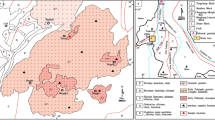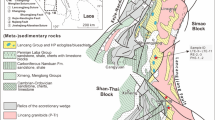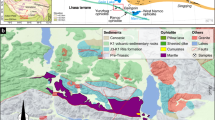Abstract
West Junggar is a key area for understanding intra-oceanic plate subduction and the final closure of the Junggar Ocean. Knowledge of the Carboniferous tectonic evolution of the Junggar Ocean region is required for understanding the tectonic framework and accretionary processes in West Junggar, Central Asian Orogenic Belt. A series of Early Carboniferous volcanic and intrusive rocks, namely, basaltic andesite, andesite, dacite, and diorite, occur in the Mayile area of southern West Junggar, northwestern China. Our new LA-ICPMS zircon U-Pb geochronological data reveal that diorite intruded at 334 (±1) Ma, and that basaltic andesite was erupted at 334 (±4) Ma. These intrusive and volcanic rocks are calc-alkaline, display moderate MgO (1.62%–4.18%) contents and Mg# values (40–59), and low Cr (14.5×10−6–47.2×10−6) and Ni (7.5×10−6–34.6×10−6) contents, and are characterized by enrichment in light rare-earth elements and large-ion lithophile elements and depletion in heavy rare-earth elements and high-field-strength elements, meaning that they belong to typical subduction-zone island-arc magma. The samples show low initial 87Sr/86Sr ratios (range of 0.703649–0.705008), positive εNd(t) values (range of 4.8–6.2 and mean of 5.4), and young TDM Nd model ages ranging from 1016 to 616 Ma, indicating a magmatic origin from depleted mantle involving partial melting of 10%–25% garnet and spinel lherzolite. Combining our results with those of previous studies, we suggest that these rocks were formed as a result of northwestward subduction of the Junggar oceanic plate, which caused partial melting of sub-arc mantle. We conclude that intra-oceanic arc magmatism was extensive in West Junggar during the Early Carboniferous.
Similar content being viewed by others
References
Aldanmaz E, Pearce J A, Thirlwall M F, et al. 2000. Petrogenetic evolution of late Cenozoic, post-collision volcanism in western Anatolia, Turkey. Journal of Volcanology and Geothermal Research, 102(1–2): 67–95.
Bas M J L, Maitre R W L, Streckeisen A, et al. 1986. A chemical classification of volcanic rocks based on the Total Alkali-Silica diagram. Journal of Petrology, 27(3): 745–750.
Beaumais A, Bertrand H, Chazot G, et al. 2016. Temporal magma source changes at Gaua volcano, Vanuatu island arc. Journal of Volcanology and Geothermal Research, 322: 30–47.
Buckman S, and Aitchison J C. 2004. Tectonic evolution of Palaeozoic terranes in West Junggar, Xinjiang, NW China. Geological Society, London, Special Publications, 226(1): 101–129.
Chen B, and Jahn B M. 2004. Genesis of post-collisional granitoids and basement nature of the Junggar Terrane, NW China: Nd-Sr isotope and trace element evidence. Journal of Asian Earth Sciences, 23(5): 691–703.
Chen B, and Arakawa Y. 2005. Elemental and Nd-Sr isotopic geochemistry of granitoids from the West Junggar foldbelt (NW China), with implications for Phanerozoic continental growth. Geochimica et Cosmochimica Acta, 69(5): 1307–1320.
Chen J F, Han B F, Ji J Q, et al. 2010. Zircon U-Pb ages and tectonic implications of Paleozoic plutons in northern West Junggar, North Xinjiang, China. Lithos, 115(1–4): 137–152.
Choulet F, Faure M, Cluzel D, et al. 2013. Architecture and evolution of accretionary orogens in the Altaids collage: The early Paleozoic West Junggar (NW China). American Journal of Science, 312(10): 1098–1145.
Coleman R G. 1989. Continental growth of northwest China. Tectonics, 8(3): 621–635.
Du H Y, Chen J F, Ma X, et al. 2019. Origin and tectonic significance of the Hoboksar ophiolitic mélange in northern West Junggar (NW China). Lithos, 336–337: 293–309.
Feng Y, Coleman R G, Tilton G, et al. 1989. Tectonic evolution of the west Junggar region, Xinjiang, China. Tectonics, 8(4), 729–752.
Filippova I B, Bush V A, and Didenko A N. 2002. Middle Paleozoic subduction belts: The leading factor in the formation of the Central Asian fold-and-thrust belt. Russian Journal of Earth Sciences, 3(6): 405–426.
Gao J, Li M S, Xiao X C, et al. 1998. Paleozoic tectonic evolution of the Tianshan Orogen, northwestern China. Tectonophysics, 287(1): 213–231.
Geng H Y, Sun M, Yuan C, et al. 2009. Geochemical, Sr-Nd and zircon U-Pb-Hf isotopic studies of Late Carboniferous magmatism in the West Junggar, Xinjiang: Implications for ridge subduction? Chemical Geology, 266(3–4): 364–389.
Geng H Y, Sun M, Yuan C, et al. 2011. Geochemical and geochronological study of early Carboniferous volcanic rocks from the West Junggar: Petrogenesis and tectonic implications. Journal of Asian Earth Sciences, 42(5): 854–866.
Grimes C B, John B E, Kelemen P B, et al. 2007. Trace element chemistry of zircons from oceanic crust: A method for distinguishing detrital zircon provenance. Geology, 35(7): 643–646.
Gu P Y, Li Y J, Zhang B, et al. 2009. LA-ICP-MS zircon U-Pb dating of gabbro in the Darbut ophiolite, West Jungar, China. Acta Petrologica Sinica, 25(6): 1364–1372. (in Chinese)
Guo L S, Liu Y L, Wang Z H, et al. 2010. The ziron U-Pb LA-ICP-MS geochronology of volcanic rocks in Baogutu areas, western Junggar. Acta Geologica Sinica (English Edition), 26(2): 471–477.
Han B F, Ji J Q, Song B, et al. 2006. Late Paleozoic vertical growth of continental crust around the Junggar Basin, Xinjiang, China (Part I): Timing of post-collisional plutonism. Acta Petrologica Sinica (5): 1077–1086. (in Chinese)
Han B F, Guo Z J, Zhang Z C, et al. 2010. Age, geochemistry, and tectonic implications of a late Paleozoic stitching pluton in the North Tian Shan suture zone, western China. Geological Society of America Bulletin, 122(3–4): 627–640.
Hastie A R, Kerr A C, Pearce J A, et al. 2007. Classification of altered volcanic island arc rocks using immobile trace elements: development of the Th-Co discrimination diagram. Journal of Petrology, 48(12): 2341–2357.
Hawkesworth C J, and Kemp A I S. 2006. The differentiation and rates of generation of the continental crust. Chemical Geology, 226(3–4): 134–143.
Hu A Q, Jahn B M, Zhang G X, et al. 2000. Crustal evolution and Phanerozoic crustal growth in northern Xinjiang: Nd isotopic evidence. Part I. Isotopic characterization of basement rocks. Tectonophysics, 328(1–2): 15–51.
Jahn B M, Wu F Y, and Chen B. 2000a. Massive granitoid generation in Central Asia: Ndisotope evidence and implication for continental growth in the Phanerozoic. Episodes, 23(2): 82–92.
Jahn B M, Griffin W L, and Windley B. 2000b. Continental growth in the Phanerozoic: Evidence from Central Asia. Tectonophysics, 328(1–2): VII–X.
Jahn B M, Capdevila R, Liu D, et al. 2004. Sources of Phanerozoic granitoids in the transect Bayanhongor-Ulaan Baatar, Mongolia: geochemical and Nd isotopic evidence, and implications for Phanerozoic crustal growth. Journal of Asian Earth Sciences, 23(5): 629–653.
Jian P, Liu D Y, Yuruo S, et al. 2005. SHRIMP dating of SSZ ophiolites from northern Xinjiang, China: implications for generation of oceanic crust in the central Asian orogenic belt. In: Sklyarov E V. Structural and Tectonic Correlation across the Central Asia Orogenic Collage: North-Eastern Segment. Guidebook and Abstract Volume of the Siberian Workshop ICCP-480. Institute of the Earth’s Crust, Siberian Branch, Russian Academy of Science, Irkutsk, 246.
Khain E V, Bibikova E V, Salnikova E B, et al. 2003. The Palaeo-Asian ocean in the Neoproterozoic and early Palaeozoic: new geochronologic data and palaeotectonic reconstructions. Precambrian Research, 122(1–4): 329–358.
Kroner A, Hegner E, Lehmann B, et al. 2008. Palaeozoic arc magmatism in the Central Asian Orogenic Belt of Kazakhstan: SHRIMP zircon ages and whole-rock Nd isotopic systematics. Journal of Asian Earth Sciences, 32(2–4): 118–130.
Liu B, Han B F, Ren R, et al. 2017. Petrogenesis and tectonic implications of the Early Carboniferous to the Late Permian Barleik plutons in the West Junggar (NW China). Lithos, 272–273: 232–248.
Liu X J, Xu J F, Wang S Q, et al. 2009. Geochemistry and dating of E-MORB type mafic rocks from Dalabute ophiolite in West Junggar, Xinjiang and geological implications. Acta Petrologica Sinica, 25(6): 1373–1389. (in Chinese)
Liu X J, Xiao W J, Xu J F, et al. 2017. Geochemical signature and rock associations of ocean ridge-subduction: Evidence from the Karamaili Paleo-Asian ophiolite in east Junggar, NW China. Gondwana Research, 48: 34–49.
Liu X J, Zhang Z G, Xu J F, et al. 2020. The youngest Permian Ocean in Central Asian Orogenic Belt: Evidence from geochronology and geochemistry of Bingdaban Ophiolitic Mélange in Central Tianshan, northwestern China. Geological Journal, 55(3): 2062–2079.
Long X P, M S, C Y, et al. 2006. Genesis of Carboniferous volcanic rocks in the eastern Junggar: constraints on the closure of the Junggar Ocean. Acta Petrologica Sinica, (1): 31–40. (in Chinese)
Ludwig K R. 2003. User’s manual for a geochronological toolkit for Microsoft Excel (Isoplot/Ex version 3.0). Berkeley Geochronology Center, Special Publication, 4: 1–71.
Pearce J. 1983. Role of the sub-continental lithosphere in magma genesis at active continental margin. In: Hawkesworth C J, Norry M J. Continental Basalts and Mantle Xenoliths. Nantwich, Cheshire: Shiva Publications, 230–249.
Pearce J, and Peate D. 1995. Tectonic implications of the composition of volcanic arc magmas. Annual Review of Earth and Planetary Sciences, 23(1): 251–285.
Pearce J. 1996. Sources and settings of granitic rocks. International Union of Geological Sciences, 19(4): 120–125.
Pearce J A, Cann J R. 1973. Tectonic setting of basic volcanic rocks determined using trace element analyses. Earth and Planetary Science Letters, 19(2): 290–300.
Ren R, Han B F, Xu Z, et al. 2014. When did the subduction first initiate in the southern Paleo-Asian Ocean: New constraints from a Cambrian intra-oceanic arc system in West Junggar, NW China. Earth and Planetary Science Letters, 388: 222–236.
Safonova I, Biske G, Romer R L, et al. 2016. Middle Paleozoic mafic magmatism and ocean plate stratigraphy of the South Tianshan, Kyrgyzstan. Gondwana Research, 30: 236–256.
Safonova I Y, Buslov M M, Simonov V A, et al. 2011. Geochemistry, petrogenesis and geodynamic origin of basalts from the Katun’ accretionary complex of Gorny Altai (southwestern Siberia). Russian Geology and Geophysics, 52(4): 421–442.
Sengör A M C, Natal’in B A, Burtman V S. 1993. Evolution of the Altaid tectonic collage and Palaeozoic crustal growth in Eurasia. Nature, 364(6435): 299–307.
Sengör A M C, Natal’in B A. 1996. Turkic-type orogeny and its role in the making of the continental crust. Annual Review of Earth and Planetary Sciences, 24(1): 263.
Shen P, Shen Y C, Liu T B, et al. 2009. Geochemical signature of porphyries in the Baogutu porphyry copper belt, western Junggar, NW China. Gondwana Research, 16(2): 227–242.
Sun W D, Mcdonough W. 1989. Chemical and isotopic systematics of oceanic basalts: Implications for mantle composition and processes. London: Geological Society, Special Publications, 42(1): 313–345.
Tang G J, Wang Q, Wyman D A, et al. 2010. Ridge subduction and crustal growth in the Central Asian Orogenic Belt: Evidence from Late Carboniferous adakites and high-Mg diorites in the western Junggar region, northern Xinjiang (west China). Chemical Geology, 277(3–4): 281–300.
Wang B, Shu L S, Cluzel D, et al. 2007a. Geochemical constraints on Carboniferous volcanic rocks of the Yili Block (Xinjiang, NW China): Implication for the tectonic evolution of Western Tianshan. Journal of Asian Earth Sciences, 29(1): 148–159.
Wang Q, Wyman D A, Zhao Z H, et al. 2007b. Petrogenesis of Carboniferous adakites and Nb-enriched arc basalts in the Alataw area, northern Tianshan Range (western China): Implications for Phanerozoic crustal growth in the Central Asia orogenic belt. Chemical Geology, 236(1–2): 42–64.
Wang Z H, Sun S, Li J L, et al. 2003. Paleozoic tectonic evolution of the northern Xinjiang, China: Geochemical and geochronological constraints from the ophiolites. Tectonics, 22(2), doi: https://doi.org/10.1029/2002TC001396.
Williams I S. 2001. Response of detrital zircon and monazite, and their U-Pb isotopic systems, to regional metamorphism and host-rock partial melting, Cooma Complex, southeastern Australia. Australian Journal of Earth Sciences, 48(4): 557–580.
Windley B F, Alexeiev D, Xiao W J, et al. 2007. Tectonic models for accretion of the Central Asian Orogenic Belt. Journal of the Geological Society, 164(1): 31–47.
Wood D A, Joron J L, and Treuil M. 1979. A re-appraisal of the use of trace elements to classify and discriminate between magma series erupted in different tectonic settings. Earth and Planetary Science Letters, 45(2): 326–336.
Wu C, Hong T, Xu X W, et al. 2018. Tectonic evolution of the Paleozoic Barluk continental arc, West Junggar, NW China. Journal of Asian Earth Sciences, 160: 48–66.
Xiao W J, Windley B F, Hao J, et al. 2003. Accretion leading to collision and the Permian Solonker suture, Inner Mongolia, China: Termination of the central Asian orogenic belt. Tectonics, 22(6): 1069.
Xiao W J, Pirajno F, and Seltmann R. 2008a. Geodynamics and metallogeny of the Altaid orogen. Journal of Asian Earth Sciences, 32(2–4): 77–81.
Xiao W J, Han C M, Yuan C, et al. 2008b. Middle Cambrian to Permian subduction-related accretionary orogenesis of Northern Xinjiang, NW China: Implications for the tectonic evolution of central Asia. Journal of Asian Earth Sciences, 32(2–4): 102–117.
Xiao W J, Windley B F, Yuan C, et al. 2009. Paleozoic multiple subduction-accretion processes of the southern Altaids. American Journal of Science, 309(3): 221–270.
Xiao W J, Mao Q G, Windley B F, et al. 2010a. Paleozoic multiple accretionary and collisional processes of the Beishan orogenic collage. American Journal of Science, 310(10): 1553–1594.
Xiao W J, Huang B C, Han C, et al. 2010b. A review of the western part of the Altaids: A key to understanding the architecture of accretionary orogens. Gondwana Research, 18(2–3): 253–273.
Xiao W J, and Santosh M. 2014. The western Central Asian Orogenic Belt: A window to accretionary orogenesis and continental growth. Gondwana Research, 25(4): 1429–1444.
Xiao W J, Windley B F, Sun S, et al. 2015. A tale of amalgamation of three Permo-Triassic collage systems in Central Asia: oroclines, sutures, and terminal accretion. Annual Review of Earth and Planetary Sciences, 43(1): 477–507.
Xinjiang Bureau of Geology and Mineral Resources (XBGMR). 1993. Regional Geology of Xinjiang Uygur Autonomy Region. Beijing: Geology Publishing House, 1–841. (in Chinese)
Xu Q Q, Ji J Q, Zhao L, et al. 2013. Tectonic evolution and continental crust growth of Northern Xinjiang in northwestern China: Remnant ocean model. Earth-Science Reviews, 126: 178–205.
Xu S L, Chen X H, Li T D, et al. 2019. Time of the ocean-continent transition in West Junggar: Constraints from zircon U-Pb dating and Lu-Hf isotopic composition. Geology in China, 46(05): 1061–1078.
Xu X, He G Q, Li H Q, et al. 2006. Basic characteristics of the Karamay ophiolitic melange, Xinjiang, and its zircon SHRIMP dating. Geology in China, 33(3): 470–475.
Xu Z, Han B F, Ren R, et al. 2012. Palaeozoic multiphase magmatism at Barleik Mountain, southern West Junggar, Northwest China: implications for tectonic evolution of the West Junggar. International Geology Review, 55(5): 633–656.
Yakubchuk A S, Shatov V V, Kirwin D, et al. 2005. Gold and base metal metallogeny of the Central Asian orogenic supercollage. In: Hedenquist J W, Thompson J F H, Goldfarb R J, et al. Economic Geology. Littleton, CO: Society of Economic Geologists.
Yang G X, Li Y J, Santosh M, et al. 2012. A Neoproterozoic seamount in the Paleoasian Ocean: Evidence from zircon U-Pb geochronology and geochemistry of the Mayile ophiolitic mélange in West Junggar, NW China. Lithos, 140–141: 53–65.
Yang G X, Li Y J, Xiao W J, et al. 2015. OIB-type rocks within West Junggar ophiolitic mélanges: Evidence for the accretion of seamounts. Earth-Science Reviews, 150: 477–496.
Yang G X, Li Y J, Tong L L, et al. 2020. An Early Cambrian plume-induced subduction initiation event within the Junggar Ocean: Insights from ophiolitic mélanges, arc magmatism, and metamorphic rocks. Gondwana Research, 88: 45–66.
Yang Y Q, Zhao L, Zheng R G, et al. 2019. Evolution of the early Paleozoic Hongguleleng-Balkybey Ocean: Evidence from the Hebukesaier ophiolitic mélange in the northern West Junggar, NW China. Lithos, 324–325: 519–536.
Yin J Y, Yuan C, Sun M, et al. 2010. Late Carboniferous high-Mg dioritic dikes in Western Junggar, NW China: Geochemical features, petrogenesis and tectonic implications. Gondwana Research, 17(1): 145–152.
Zhang J E, Xiao W J, Han C M, et al. 2011. A Devonian to Carboniferous intra-oceanic subduction system in Western Junggar, NW China. Lithos, 125(1–2): 592–606.
Zhang J E, Xiao W J, Luo J, et al. 2018. Collision of the Tacheng block with the Mayile-Barleik-Tangbale accretionary complex in Western Junggar, NW China: Implication for Early-Middle Paleozoic architecture of the western Altaids. Journal of Asian Earth Sciences, 159: 259–278.
Acknowledgements
This study was jointly supported by the CAS “Light of West China” Program (2018-XBYJRC-003), the National Natural Science Foundation of China (41772059, 92055208), the Guangxi Natural Science Foundation for Distinguished Young Scholars, China (2018GXNSFFA281009), and the Fifth Bagui Scholar Innovation Project of Guangxi Zhuang Autonomous Region, China. We are grateful for editor’s excellent editorial handling and constructive comments from two anonymous reviewers, which substantially improved the final presentation of the manuscript. This is a contribution to International Geoscience Programme (IGCP) 662 and Guangxi Key Mineral Resources Deep Exploration Talent Highland.
Author information
Authors and Affiliations
Corresponding author
Rights and permissions
About this article
Cite this article
Liu, P., Liu, X., Xiao, W. et al. Geochronology, geochemistry, and Sr-Nd isotopes of Early Carboniferous magmatism in southern West Junggar, northwestern China: Implications for Junggar oceanic plate subduction. J. Arid Land 13, 1163–1182 (2021). https://doi.org/10.1007/s40333-021-0069-2
Received:
Revised:
Accepted:
Published:
Issue Date:
DOI: https://doi.org/10.1007/s40333-021-0069-2




